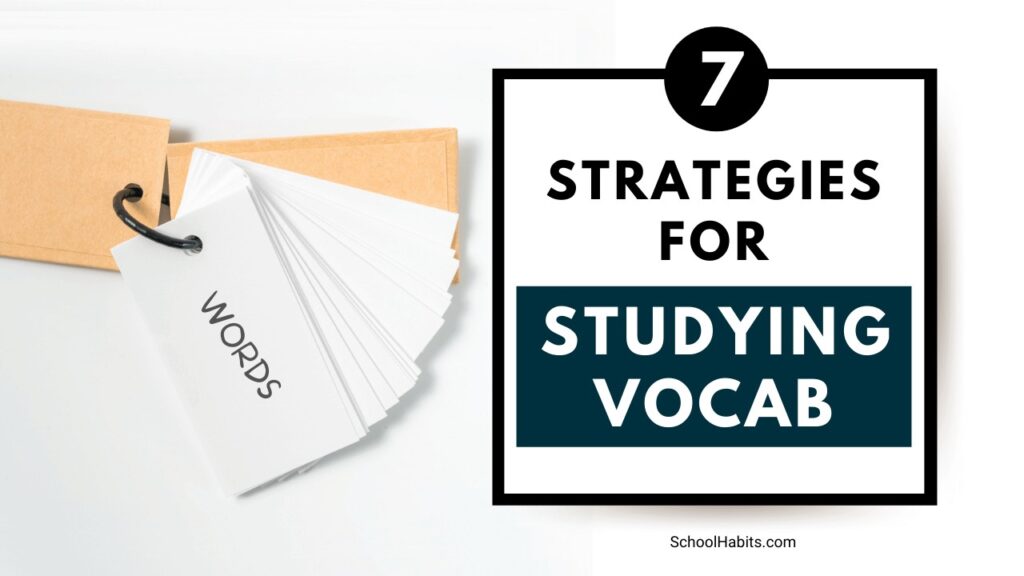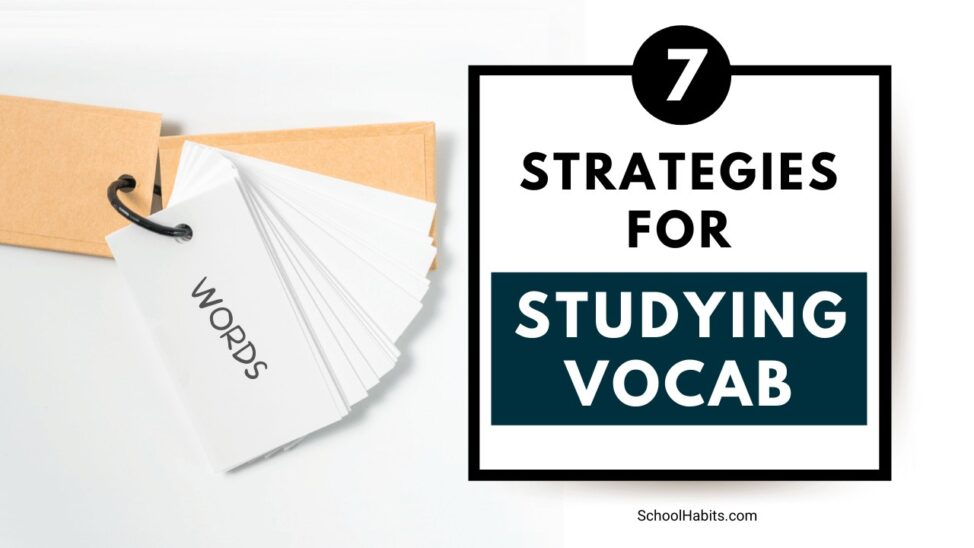By Katie Azevedo, M.Ed.

You will need to learn and study vocabulary words no matter what grade you’re in or what class you take. Sure, you will probably have more vocab quizzes in English or Spanish class, but you will also need strategies for studying vocabulary words in biology (mitosis, meiosis), history (diaspora, humanism), psychology (cognitive dissonance, cerebellum), etc.
Vocabulary is essentially the common denominator of all your classes and there’s no escaping it. That means that having solid strategies for studying vocabulary is one of the best ways to improve across all your classes through all of school.
I know that sounds cheesy and dramatic, but here we are.
Strategies for studying vocabulary
Below, I’m sharing 7 vocabulary study methods that, if used properly, really do work. You don’t have to use them all at once, but I suggest trying each one and settling on a few that you like the best. Many of the strategies I’ve written about on my blog before, and so I link to those tutorials where appropriate.
1. Use the scaling technique.
The scaling technique (also called a semantic gradient) makes you connect a new word in varying degrees to words you already know. Remember, the only way to learn new information is by connecting it to what we already know. There are 3 steps to using the scaling technique, which I explain thoroughly and with examples here, but generally speaking, the steps are:
- Choose a word from your vocabulary list, and then think of a word that is opposite.
- Place the original word and its opposite word on separate ends of a vertical line. This is the framework for your scale. (See image.)
- To complete your scale, fill in the space between each word with several new words of varying degrees of meaning. Think of your scale as a continuum.
The scaling technique only works for words that have antonyms (opposites), and so it does not work for all vocabulary.
2. Use the Frayer Model.
The Frayer Model has been around forever – and that’s because it works. Basically, the Frayer Model is a graphic organizer that contains 4 boxes (a 2×2 grid) with the vocabulary word in the middle. You fill in each of the four boxes with one of the following: definition, facts/characteristics, examples, and non-examples. Here is my FREE Frayer Model Template (it’s a pdf so you can print it or use it digitally.) This strategy works because it gets you thinking about a vocabulary word from different angles, which must happen if we want to really learn the word. Here’s exactly how to use the Frayer Model.

3. Study in both directions.
Another great strategy for studying vocabulary is to study the words in both directions: forward and backward. This is a simple study tip, but it works. For example, if you’re learning the word amino acid, you should be able to generate the definition by looking at the word, and also be able to generate the word by looking at the definition. Here’s a more detailed explanation of how to study in both directions.
4. Make it visual.
According to Brain Matters by neuroscientist Dr. Patricia Wolf, “The eyes contain nearly 70% of the body’s sensory receptors,” which means that we “take in more information visually than through any of the other senses.” If I said the word cactus, you would likely envision a prickly green plant, rather than recite its DNA sequence. We think in pictures and we learn with pictures.
Use this learning theory to your advantage and incorporate images as much as possible when you’re studying vocabulary. For example, you can use this visual learning strategy, or use Google Images (my favorite strategy) when learning new words. (So, instead of doing a regular Google web search for something you’re learning, filter by Google Images to get a variety of visual results including visual presentations, pictures, infographics, charts, etc.)
5. Think about the word.
Wait – don’t go! You might think it’s a weird strategy, but it’s for real. If you study a word by just looking at its definition (even if you do this repetitively), you are only accessing that word from ONE angle. You only see and understand ONE side of the word. You only give yourself ONE handle by which to grab on to the word and remember it. Uncool and ineffective.
So, you have to think about the word. Work with it. Talk about it. Picture it. Draw it. Explain it. Connect it to something else you know. Get uncomfortable and weird. Think.
When you really think about a word, you come at it from different angles, which increases your understanding of the word as well as your ability to remember it over time. Here’s how to use this vocab strategy – step by step.
6. Use flashcards with the 3-pile method.
Of course, one of the most familiar strategies for studying vocabulary is using flashcards. Flashcards work so well because they use active recall, which is the ultimate way to learn anything, not just vocab. So, you know how to use flashcards, but do you know about the 3-pile method?
7. Understand the word; don’t memorize it.
So many people try to memorize vocab terms, sometimes even memorizing the dictionary definition word-for-word. First of all, you should always study your own wording and not someone else’s (your brain will have an easier time storing it). Second, you have to understand something before memorizing it. Maybe read that sentence again. There is a sequence to the learning process, and understanding comes first, well before memorization. Memorization is not learning, and I explain that important difference here. (You should read that.)
Important information about learning vocabulary
Word learning happens in four stages. To really learn vocabulary words long-term, you need to get to the fourth stage. To get to the fourth stage – full word knowledge – you need to be deliberate about the strategies you use for studying vocabulary, and you need to let go of the idea that you can rely on memorization, “looking over” vocab lists, and other passive forms of review.
Below are the four stages of word acquisition, which can help you assess where you’re currently at and how far you need to go.
- Unknown word: You don’t recognize the term
- Initial recognition: You’ve seen or heard the term before, you might be able to pronounce it, but you don’t know the definition
- Partial word knowledge: You know one common definition of the word and can use it in a simple sentence
- Full word knowledge: You know more than one definition of the word and can use the word in various contexts
If you’re studying more than just vocabulary, but you’re still a fan of index cards, then here are 10 different ways to use index cards to study.

